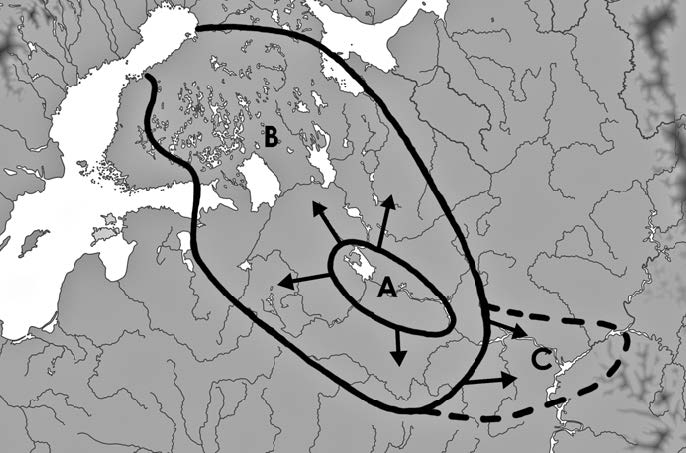Asko Parpola has recently published a new paper, Finnish vatsa ~ Sanskrit vatsá and the formation of Indo-Iranian and Uralic languages.
Abstract:
Finnish vatsa ‘stomach’ < PFU *vaćća < Proto-Indo-Aryan *vatsá- ‘calf’ < PIE *vet-(e)s-ó- ‘yearling’ contrasts with Finnish vasa- ‘calf’ < Proto-Iranian *vasa- ‘calf’. Indo-Aryan -ts- versus Iranian -s- refl ects the divergent development of PIE *-tst- in the Iranian branch (> *-st-, with Greek and Balto-Slavic) and in the Indo-Aryan branch ( > *-tt-, probably due to Uralic substratum). The split of Indo-Iranian can be traced in the archaeological record to the differentiation of the Yamnaya culture in the North Pontic and Volga steppes respectively during the third millennium BCE, due to the use of separate sources of metal: the Iranian branch was dependent on the North Caucasus, while the Indo-Aryan branch was oriented towards the Urals. It is argued that the Abashevo culture of the Mid-Volga-Kama-Belaya basins and the Sejma-Turbino trade network (2200–1900 BCE) were bilingual in Proto-Indo-Aryan and PFU, and introduced the PFU as the basis of West Uralic (Volga-Finnic) into the Netted Ware Culture of the Upper Volga-Oka (1900–200 BCE).
He updates thus his quite recent model from On the emergence, contacts and dispersal of Proto-Indo-European, Proto-Uralic and Proto-Aryan in an archaeological perspective (2017).
In it he supported a North-West Indo-European expansion with Corded Ware, and a Neolithic Proto-Uralic community in East Europe (associated with the Comb Ware culture), as I did before the famous 2015 papers.
In fact, he supports that the satemization trend of Proto-Indo-Iranian is due to a Proto-Finno-Ugric substratum in its population in the Volga-Ural region, similar to the model I propose (with the Corded Ware substratum hypothesis).
NOTE. While for Parpola the ‘satemizing’ substratum of Balto-Slavic (a NWIE dialect) may not come exactly from the same Finno-Ugric population as for Indo-Iranian, but from a different Uralic dialect (as I explain in my hypothesis), for the few extant supporters of an Indo-Slavonic group there should not be any problem identifying the same ancient substrate as for the Proto-Indo-Iranian population…
Now that North-West Indo-European is clearly associated with the Yamna -> Bell Beaker expansion, I understand that his previous model is obsolete and needs a revision.
I find it especially difficult to understand (in light of his previous theory) why he compares Indo-Aryan *vatsa– and Iranian *vasa– to assert that the former is the origin of the loanword in Finno-Ugric, when the Proto-Indo-Iranian form is essentially the same as the Indo-Aryan one, with respect to the *w– evolution into *v– in both PII and late FU dialects…
NOTE: I wrote him yesterday asking for this issue, I will post here his answer.
EDIT (20 MAR 2018): The summary of his answer regarding his selection of Indo-Aryan *vatsa– vs. Iranian *vasa– (instead of just PII *watsa-/vatsa-) is one based on Archaeology (and likley guesstimates), since he understands the split into Iranian and Indo-Aryan to have happened early within the Yamna culture, so that the cultural admixture of Abashevo must have happened after the separation.

His effort to link the actual expansion of Finno-Ugric to Corded Ware territory, linking it also partially to population movements from the Seima-Turbino phenomenon – probably associated with the initial expansion of N1c lineages – is another good example of convergence of the different anthropological theories thanks to recent Genomic studies.
Related:
- North Pontic steppe Eneolithic cultures, and an alternative Indo-Slavonic model
- Olalde et al. and Mathieson et al. (Nature 2018): R1b-L23 dominates Bell Beaker and Yamna, R1a-M417 resurges in East-Central Europe during the Bronze Age
- Corded Ware pastoral herding economy and belief system through mortuary practices
- Corded Ware culture contacts in the Baltic Sea region linked to immigrant potters
- The concept of “Outlier” in Human Ancestry (III): Late Neolithic samples from the Baltic region and origins of the Corded Ware culture
- Genetic prehistory of the Baltic Sea region and Y-DNA: Corded Ware and R1a-Z645, Bronze Age and N1c
- Science and Archaeology (Humanities): collaboration or confrontation?
- Massive Migrations? The Impact of Recent aDNA Studies on our View of Third Millennium Europe
- Another hint at the role of Corded Ware peoples in spreading Uralic languages into north-eastern Europe, found in mtDNA analysis of the Finnish population
- Recent archaeological finds near Indo-European and Uralic homelands
- New Ukraine Eneolithic sample from late Sredni Stog, near homeland of the Corded Ware culture